Part
6 : The Seaside Holiday Photograph (continued)
The
Beach Photographer
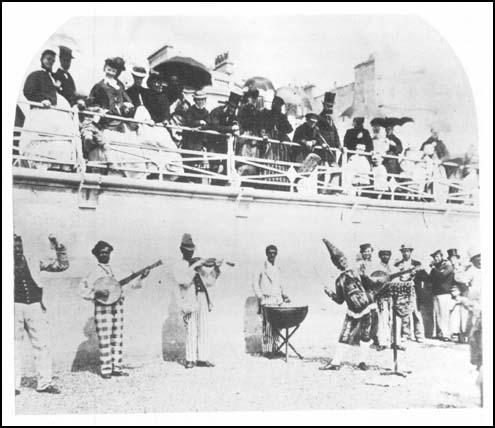
Beach entertainers, including
a black minstrel band, on Brighton Beach in the mid 1860s
The
Beach Photographer
Crowds
of holiday-makers on Brighton beach were bound to attract traders
and entertainers. Vendors of food and drink, hawkers selling souvenirs
and cheap jewellery and musicians and beach entertainers were
joined by itinerant photographers.
In
the late 1850s, visitors to Brighton could return home with a
cheap collodion positive or ambrotype portrait taken
at one of a dozen or more studios in the centre of town. In the
1860s and early 1870s, visitors could obtain a souvenir of their
stay in Brighton in the form of a carte de visite portrait,
available from nearly three dozen photographic studios. From the
late 1870s, itinerants equipped with tintype cameras descended
on seaside towns and with the advent of dry plates and 'instantaneous'
photography in the 1880s profesional photographers could leave
their studios and come down to the beach to find customers. In
Brighton, professional photographers could set up small studios
and workrooms in the Arches under the Kings Road and still maintain
better equipped and more orthodox studios in town. In 1878, for
example, William Dawson was operating a photographic room
alongside the beach, near the West Pier, yet at the same time
his firm of Dawson & Co had a studio in Brighton's
London Road.
Tintype
Portraits on the Beach
In
other seaside towns in the south of England, such as Hastings,
beach photographers carried portable dark rooms on little handcarts,
which they trundled over the beach itself. A number of the photographers
who wheeled handcarts along the beach produced tintype
portraits on a "while you wait" basis. The tintype
process was particularly suitable for producing "instant
portraits".Many of the beach photographer's customers were
"day trippers" and so it was important that the photographic
portrait could be developed on the spot.
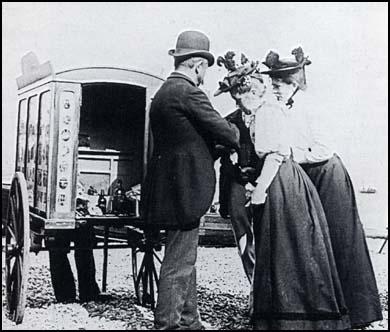
Beach
photographer with his portable darkroom on wheels.
The
tintype portrait was ideal for beach photography, in that it was
cheap, fast to produce and processed on a durable metal base,
rather than a fragile glass plate.Tintype portraits were sold
for as little as 6d each, being the cheapest format of photographic
portrait available.
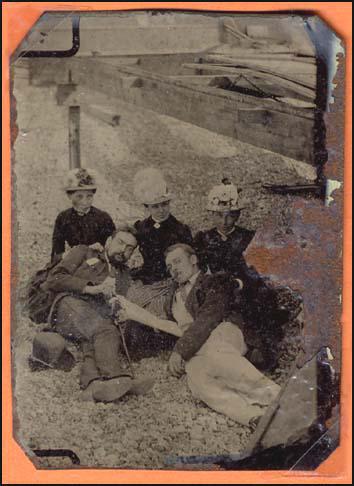
Tintype
group portrait taken by a beach photographer(c1892).
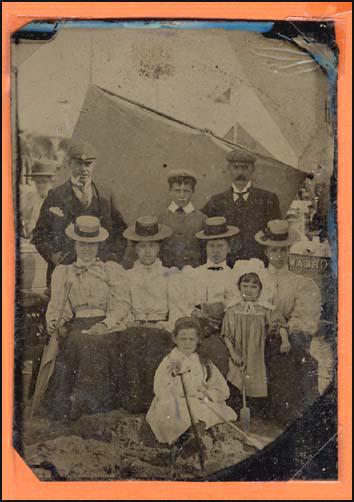
Tintype
group portrait taken by a beach photographer(c1895).
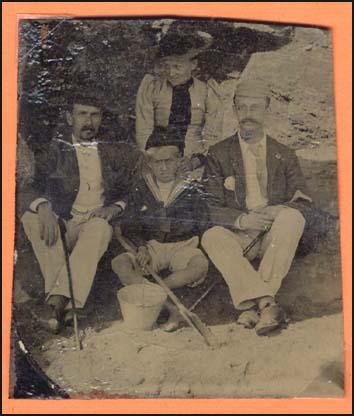
Tintype
group portrait taken by a beach photographer (c1892).
Temporary
and Permanent Studios on the Seafront
At
some seaside resorts it was necessary to pitch a large tent on
the beach to serve as a temporary studio and darkroom.In the age
of wet collodion and ambrotypes some itinerant photographers found
it necessary to arrive on the coast in a customised photographic
carriage.In the late 1850s, Mr H Neale from Tunbridge Wells made
seasonal visits to Hastings in the Monarch Photographic Carriage.
In Eastbourne in the early 1860s, Mr Bennett's Photographic Carriage
would arrive each August "for the season".
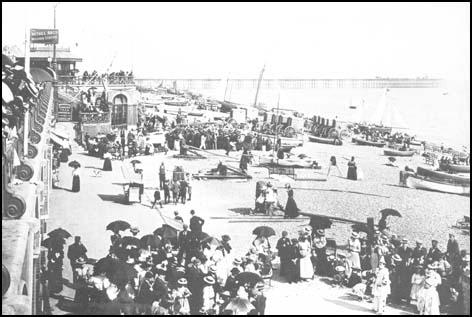
The Beach and the Lower Esplanade,
Brighton in 1898. Richard Cartwright and his son had a photographic
studio in the Arches, on the left of the photograph, from 1888
to 1910 and beyond. A camera on its tripod can be seen at right
centre of the beach, next to the stout lady standing between the
boats
In
Brighton it was possible to establish small permanent photographic
studios alongside the foreshore.Over a long stretch of Brighton's
seafront, a series of small shops occupied the arches below Kings
Road. From the mid 1870s, beach photographers were able to set
up small studios and photographic rooms in the Kings Road
Arches, from where they could operate a beach photography
service. On the eastern seafront near the Chain Pier, small
photographic studios were established on Madeira Road (
now known as Madeira Drive ).
Itinerant
and Freelance Photographers on the Beach
It
is difficult to say exactly how many photographers were working
Brighton beach at any one time. Evidence form other Victorian
seaside resorts suggests a large number. In 1882, a policeman
estimated that on one particular day some forty to fifty photographers
were working on the sands at Ramsgate. In Blackpool in 1895, around
three dozen beach photographers were counted on a single day.
However, in Brighton the situation may have been rather different.
Going
through the 1891 Census returns for Brighton and Hove,
I counted 173 individuals associated with the business of photography.
The majority of the photographers recorded, around a hundred names,
declared that they were employed as apprentices, assistants or
operators in Brighton's established photographic studios. A Brighton
Directory of 1891 lists nearly 50 studio addresses. Of the 54
photographers who described themselves as employers or self employed,
47 names can be identified as proprietors of studios. Only 7 photographers,
therefore, can be regarded as working independently on their own
acocunt possibly as street or beach photographers
At
the time of the 1901 Census, there were over 160 inhabitants
of Brighton & Hove who were working in the field of photography.
Out of this total, only 18 can be classified as independent photographers
working on their own account, but not based in a photographic
studio.
The
1891 Census was carried out on 5th April and the 1901 Census was
taken on 31st March 1901, a period of the year when beach photographers
would not have been very active. It is likely that a number of
photographers travelled down to Brighton from London for a particular
Bank Holiday.
Competition
and Disputes between Beach Photographers
The
existence of permanent photographic studios alongside Brighton's
seaside promenades did not deter itinerant portrait takers and
freelance beach photographers. Audrey Linkman, who has made a
special study of itinerant photographers, has trawled through
the minutes of the Brighton Beach Committee and discovered evidence
of disputes between resident studio proprietors and photographers
who operated near their premises with portable equipment. In her
book, " The Victorians - Photographic Portraits ",
Audrey Linkman gives details of a series of complaints against
interlopers made by proprietors of the Chain Pier Studio located
on Madeira Road. A letter of complaint from Alfred Sharp
of the Chain Pier Studio was received by the Brighton Beach Committee
in January 1881. In the letter, Alfred Sharp makes a grievance
against Thomas Foulkes, whom he alleges was standing near
his premises on Madeira Road " with a box and camera for
the purpose of taking photographs". In fact, Thomas Foulkes
was not an itinerant photographer but a professional photographer
who had previously operated a studio on Brighton's western seafront.Over
the next year or so Mr Sharp wrote letters of complaint about
a competitor working at Arch 15 under Junction Road and another
opposite the Aquarium Clock Tower.
CLICK HERE TO CONTINUE
The Beach, Kings Road Arches and the
Lower Esplanade